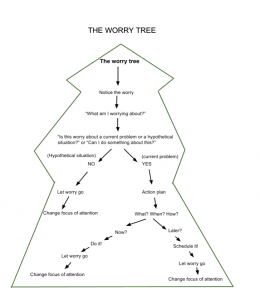As someone who lives with generalized anxiety disorder, I’m really struggling at the moment. There is simply so much going on in the world that I don’t know what to worry about first.
- Should I worry whether Christmas will be cancelled for the second year in a row?
- Or whether the Christmas tree might catch fire while I’m not in the room?
- Or whether the dog will decide the tree decorations look tasty?
- Or what might happen if my chronically ill mum gets Covid?
- Or how my tinnitus is going to react at any social gatherings we do get to attend?
It is, quite frankly, exhausting.
Thankfully I have a helpful tool at hand. I was given this when I had Cognitive Behavioural Therapy and have used it ever since. It’s called The Worry Tree.
The Worry Tree helps us with two different types of worries:
1. Hypothetical problems (the “what ifs”) and
2. Current problems
Hypothetical problems
Hypothetical problems – those “what if” thoughts – take our current situation and predict the worst case scenario. This is also known as catastrophizing. Examples familiar to many of us with tinnitus are:
- My tinnitus is louder today. What if this volume becomes my new normal?
- I’ve had tinnitus for a month now. What if I never hear silence again?
- My tinnitus has woken me up the last two nights. What if I never get a good night’s sleep?
- I’m really struggling to concentrate at work today. What if I make a mistake and I get fired?
We might think we’re helping ourselves by worrying about these situations, and planning what to do in the event the worse happens. But often there is little we can do to change the situation we‘re in. And odds are the outcomes we are predicting will never happen. So all that time and energy we have spent worrying and planning has been for naught.
“I’ve had a lot of worries in my life, most of which never happened.”
Mark Twain
Current problems
Current problems relate to a real situation that we can potentially do something about. Some familiar examples are:
- I’m worried my tinnitus is caused by an acoustic neuroma [solution: speak to your doctor about your concerns and arrange an MRI if appropriate]
- I’m worried that the gig tonight will make my tinnitus worse [solution: use earplugs that will reduce the volume while still allowing you to enjoy the music.]
In these cases we have the opportunity to do something to address the problem. Deciding what to do, how to do it and when to do is infinitely more helpful than continually worrying about the issue.
“Don’t just sit there and worry. Be proactive. Do something – anything – about what’s worrying you so you can gain information, focus and control over the situation.”
Mark Twain
How to use The Worry Tree
The Worry Tree is very simply to use. When you notice that you are anxious about something, simply follow the steps to determine which path to take.
If you are a professional worrier like me, it’s useful to print out a copy of The Worry Tree and stick it in a desk drawer, or in your bag, so you can pull it out when needed. It’s also available as an app here: Worry Tree Mobile App
If you try The worry Tree I’d love to know how it works for you.

